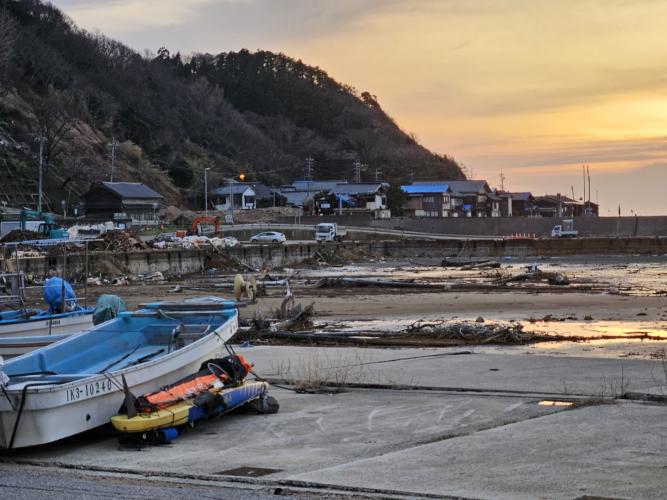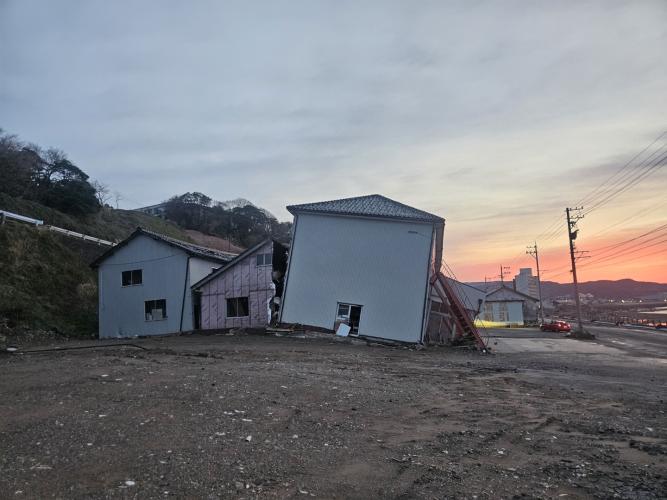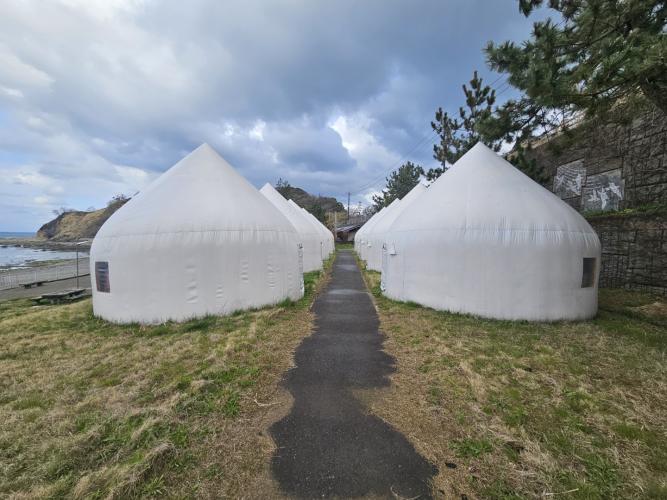Noto - towards the Epicentre
March 27th - to Shinbo
Windless AM. Around midday I give up waiting and make some miles with the paddle. It soon gets rather choppy, so I am thankful for the faint trickle of breeze that also arrives. The chop continues to build, and rebound with interest from reflective shores. The most perfect mirrors are port walls. Around me, white horses tumble in defiance of Lord Beaufort's mandate. Despite the absence of wind, clearly it is blowing hard nearby.
The sail begins to tug, and in the same moment the board finds momentum to surf down the slopes. My concern now is that the wind will build too much. For an easier check on the forecasts I pull into a little port where some friendly locals wave me in and help me up the slip. It's difficult to leave after a kind welcome, and I really don't like the weather, so that becomes that for the day. The sail sleeps derigged and when Yumiko arrives we drive off to find a more sheltered campsite.
March 28th - to Noroshi Port
Thunderstorms overnight, but by morning the sea has reset to flat. The wind angle isn't terrible, but requires a close-hauled crossing of a concave curve of coastline, or horribly-slow zigzags if hugging the shore. I choose the direct crossing, and am shivering with cold upon reaching the other side, so stop for a run on the beach and to better wrap myself up. Even in gloom, this beach is the friendliest I have met on this journey. Onwards, the coast bends round and becomes the end of the peninsula proper: beach gives way to rock, the waves are larger, and the wind blows harder and comes directly on the nose. I push on to (just shy of) the corner where the coast becomes north facing, and am well-pleased with my effort for the day.
On land, today more than yesterday, earthquake damage is evident: roads are buckled, posts askew, wooden houses collapsed under the weight of their ceramic tile roofs. Even the public toilets are out of order, though impeccable portaloos are available nearby and these would still shame any European nation's WC offering.
March 29th - to Nafune
Biggish swell to be "sailing" in such a light breeze. In fact, I paddle - mostly prone - for 4 nm to reach level with the "guaranteed" landing of a respectably sized port. Awful. Is it the board or my knees that crack in complaint? I am set to quit for the day, but a gentle onshore arrives to complicate the decision. It's too early to quit. I decide upon "one more port": another 5 nm. This next port is much smaller and the wind is already on the wane as I approach it. Breaking waves prevent an approach. I can see no way in. I have some more "red flag" (sketchy) landing options identified ahead, and decide to continue to those. Likewise, these offer no way in. I thank my lucky stars that I started early, and still have plenty of daylight to reach the next good-sized port: Nafune. The wind is kind enough to carry me most of the way. There should be a stress free landing behind the port wall, but it is far too shallow! There is no water. The port is... silted up? Filled by a landslide? Anyhow, this is my best and only option, so an analysis can wait. Before committing I prepare for a swim: no point drowning myself with an open drysuit. When the waves are off-set I paddle hard, round the end of the tetrapod wall, and the next surge of swell pushes me not into calmer water but up upon dry sand.
Inside, the port is a scene of devastation. The sea has emptied-out as if at low spring tide, though this is a sea without rise and fall. There has been landslip from the cliffs behind, but it seems to be insufficient to account for the filling of the port. It is difficult to comprehend, and in truth I fail to comprehend until reading that the north coast of the Noto Peninsula was uplifted by up to 4 metres when the earthquake hit on January 1, 2024.
March 30 - no sailing
Today was rainy (sometimes snowy) and too wild to sail, particularly with landings so uncertain. We took a drive back up to the ex-ports - now communities that have lost their access to the sea. Ex-communities, really. Many people were left homeless, as refugees, and now reside in temporary prefab shelters. It is sad far beyond the initial death toll of the quake. There is much to contemplate, much to say — but these words are insufficient. Some pictures will speak instead.
 Tucked up with the local boats who can no longer reach the sea
Tucked up with the local boats who can no longer reach the sea
 Wherever you look, there is earthquake damage
Wherever you look, there is earthquake damage
 Emergency accommodation occupies most municipal green space around Wajima town.
Emergency accommodation occupies most municipal green space around Wajima town.